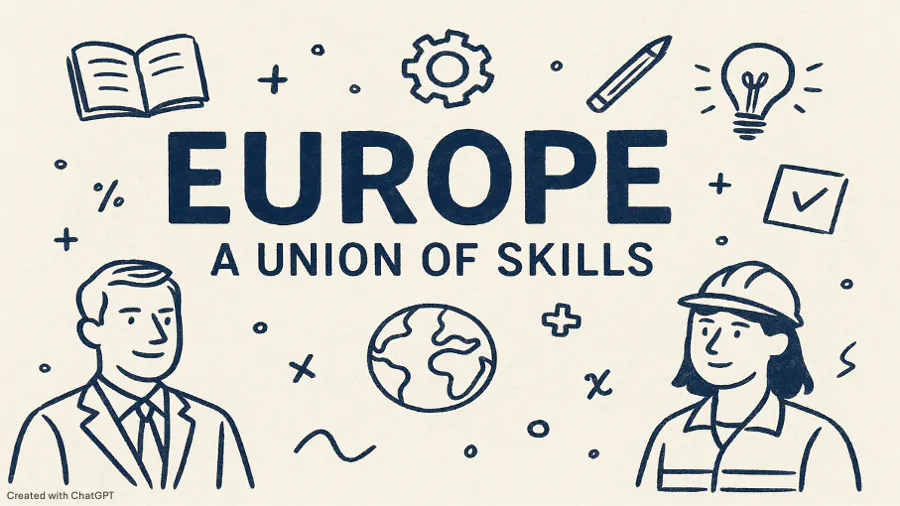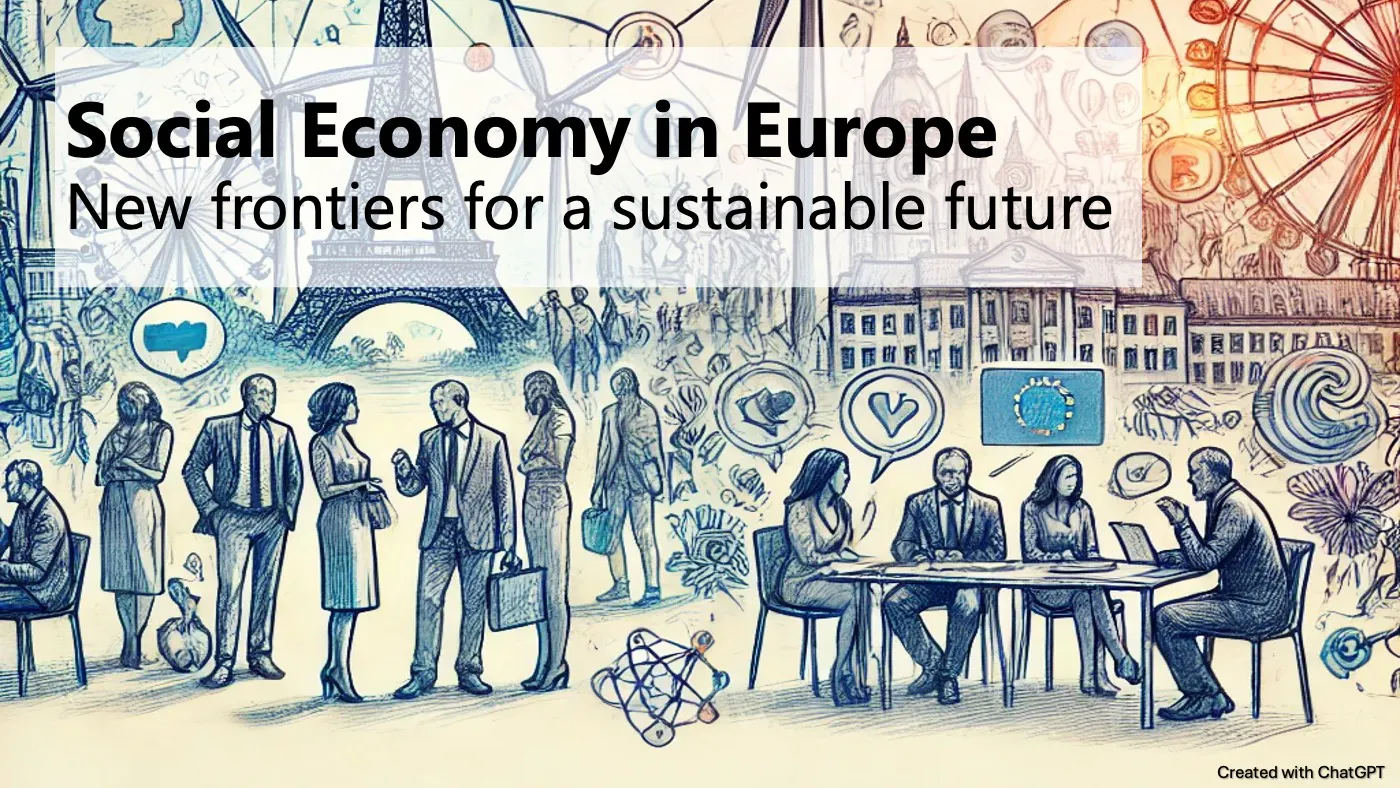Europe, a union of skills: Tackling Europe's talent trap
May 2025

Global competition, demographic shifts and technological change demand a workforce that is more agile, skilled and mobile than ever before. Yet, many European regions are caught in a downward spiral, with an aging population, young people and skilled workers leaving, businesses struggling to find talent, investment drying up and regional development slowing.
In response to these challenges, the European Commission has launched the concept of a 'Union of Skills' to rethink how Europe educates, connects and retains its workforce. Initially, the idea of a ‘Union of Skills’ is spatially blind, but it will certainly have an impact on regional development, both in regions left behind and facing talent traps, and in thriving regions. Optimistically, it could become a strategic answer to a fundamental question: How can Europe ensure that all people and places have a future in the green and digital age? It could reframe skills not just as a matter of individual empowerment, but as a foundation for collective resilience, inclusion and territorial balance.
The talent trap: A challenge for regional development
The skills shortage is not new, but it has become one of the EU's pressing structural problems. By 2023, more than three-quarters of companies in some member states reported difficulties in finding workers with the right skills. Demographic trends are exacerbating the situation: between 2022 and 2030, the EU's working-age population is expected to shrink by 3.5 million people.
Some regions will be particularly hard hit. The European Commission's 2023 Communication Harnessing talent in Europe's regions (Opens in a new window) introduced the idea of 'talent traps'. These are areas that are simultaneously experiencing population decline, a shrinking share of tertiary educated people and a net brain drain. Most are in Eastern and Southern Europe, but many rural and post-industrial areas in the West face similar challenges.
The talent trap is not just a demographic issue. It reflects structural weaknesses in education systems, labour market mismatches and a lack of investment in innovation and quality jobs. The result is a vicious circle that fuels inequalities between Europe's regions. It puts pressure on the EU's goal of territorial cohesion.
From an EU Skills Agenda to a Skills Union
The idea of a ‘Union of Skills’ is the next step in the EU's efforts to address the skills and talent challenge. The European Skills Agenda 2020 (Opens in a new window) already outlined the need for up-skilling and re-skilling to enable Europe's green and digital transitions. It also introduced tools such as the Pact for Skills and the concept of micro-credentials. This was followed, among others, by Communication Skills and Talent Mobility (Opens in a new window) and on Harnessing talent in Europe's regions (Opens in a new window) introduced, both in 2023. Indeed, 2023 was the European Year of Skills intended to raise awareness and stimulate investment in education and training.
Finally, in March 2025, the Commission published the Communication on The Union of Skills (Opens in a new window) which consolidates these ideas into a comprehensive EU strategy.
The term 'Union of Skills' was already launched in policy discussions in the context of the Strategic Agenda 2024 and was taken up by Enrico Letta's in his report ‘Much more than a market’ on the future of the Single Market. Letta identified the 'Union of Skills' as one of the key pillars for deepening integration and boosting competitiveness. The idea is also in line with Mario Draghi's competitiveness review, which highlights human capital as a key factor in the EU's economic resilience.
What does the Union of Skills aim to achieve?
The 'Union of Skills' aims to ensure that everyone in the EU has access to the right skills at the right time, regardless of where they live. It is based on four interlinked objectives:
Building skills for quality jobs and lives. The initiative focuses on strengthening basic skills such as literacy, numeracy, science and digital literacy. It includes the launch of a Basic Skills Support Scheme and a Science, Technology, Engineering and Mathematics (STEM) Education Strategic Plan to promote careers in science, technology, engineering and mathematics, with a focus on increasing female participation.
Regular upskilling and reskilling. Recognising the need for continuous learning, the strategy proposes to expand the use of micro-credentials and strengthen the Pact for Skills to help workers acquire new skills in strategic sectors. It also plans to pilot a skills guarantee to provide workers at risk of unemployment with opportunities to acquire new skills.
Facilitating skills mobility across the EU. To maximise the potential of the single market, the 'Union of Skills' aims to improve the transferability of skills and qualifications between EU countries. Initiatives include the development of a European degree, a new European vocational diploma, and the strengthening of European university alliances to support cross-border education and employment opportunities.
Attracting, developing and retaining talent. The strategy aims to make the EU more attractive to global talent by creating an EU talent pool to recruit job seekers from outside the EU, presenting a visa strategy to facilitate the entry of top students, skilled workers and researchers, and launching the ‘Choose Europe' initiative under the Marie Skłodowska-Curie Actions to attract and retain talent.
Taken together, these actions should increase opportunities for individuals, improve labour market efficiency and make the EU economy more resilient.
Implications for regional development and cohesion
The 'Union of Skills' is an ambitious attempt to tackle one of Europe's most complex and politically sensitive issues. It recognises that the future of European competitiveness depends not only on capital and technology, but also on people and their ability to learn, adapt and move.
But it is not just an economic strategy. It is also a territorial one. Indeed, it recognises that skills shortages and brain drain are unevenly distributed and closely linked to regional development patterns. It explicitly calls for targeted support for regions in a talent trap and stresses the need for better coordination with cohesion policy.
This territoriality can be illustrated on two points:
Skills, mobility and EU integration. Labour mobility is one of the fundamental freedoms of the EU. Yet in practice many people still face challenges when moving between countries. Qualifications may not be recognised, social protection may be difficult to transfer, and language or administrative barriers remain high. The 'Union of Skills' addresses these obstacles head-on. By investing in the recognition of micro-credentials and creating EU-wide diplomas, it aims to facilitate cross-border mobility for learners and workers alike. It also links skills development to wider European integration goals by supporting networks of universities, employers and public services across borders. The message is clear: free movement of workers should not be a burden for some and a privilege for others. It must become an accessible and secure choice for all EU citizens, underpinned by a common framework of skills and rights.
Trapped regions. The compunction on the 'Union of Skills' points towards particular skills challenges in rural areas. However, this might not only concern rural areas. For lagging regions – particularly those caught in a talent trap – the initiative offers both opportunities and challenges. On the one hand, it can bring investment in education and training, support local up-skilling and help retain talent through better job prospects. On the other hand, increased mobility could also accelerate brain drain if not accompanied by place-based development strategies. This calls for targeted support to vulnerable regions and greater synergies with cohesion policy.
In short, cohesion policy post-2027 should become a partner in the 'Union of Skills'; and not just a passive recipient, but an active co-designer.
Success will depend on implementation, but also on political will. If well coordinated, it could be a real game changer; both for individuals seeking a better future and for regions seeking to escape the talent trap. But for this to happen, the 'Union of Skills' must be designed with territorial cohesion in mind - not just as an afterthought, but as a core objective.
by Kai Böhme
 (Opens in a new window)
(Opens in a new window)


